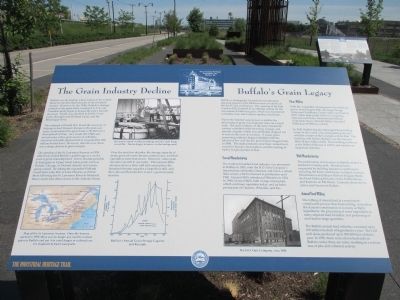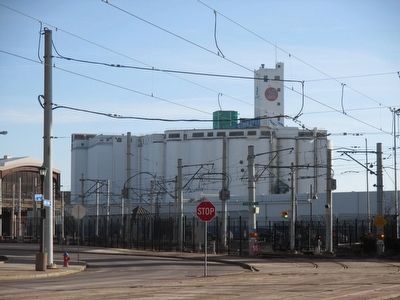First Ward in Buffalo in Erie County, New York — The American Northeast (Mid-Atlantic)
The Grain Industry Decline / Buffalo's Grain Legacy
The Industrial Heritage Trail
Inscription.
Buffalo was the leading wheat market in the United States for the first three decades of the twentieth century. However, by the 1930s, Buffalo's strategic position in the grain trade weakened as U.S. and Canadian grain began to bypass the port's transfer elevators. Traffic was diverted to Pacific Coast port, the improved Welland Canal, and the Mississippi River.
The outbreak of World War II and the necessity of helping to feed Western Europe in the post-war years re-stimulated the grain trade in Buffalo for a short period of time. As a result, the 1940s saw several years when grain received in Buffalo elevators and mills approached or exceeded the 300 million bushel level. However, after the war, there was a sharp decline in grain receipts.
The opening of the St. Lawrence Seaway in 1959 effectively ended Buffalo's golden age as a world port of grain transshipment. It now became possible to load grain in Upper Great Lakes ports (such as Duluth, Chicago, or Detroit) directly onto ocean-going vessels. By taking the expanded Welland Canal from Lake Erie to Lake Ontario, and from there following the St. Lawrence River to Montreal, these vessels had direct access to the Atlantic Ocean.
Map pf the St. Lawrence Seaway. Once the Seaway opened in 1959, there was no longer any need to unload grain in Buffalo and put it in canal barges or railroad cars for shipment to East Coast ports.
Stevedores (dock workers) loading an Erie Canal Barge, circa 1934. The Kellogg Elevator is in the background.
Over the next few decades, the storage capacity of many grain elevators became unnecessary, and their operations were shut down. However, some grain elevators are still in use today. The General Mills elevator serves a flour mill and cereal plant, the Standard elevator supplies a large flour mill, and the Lake Erie and Rail elevator is now a grain transfer elevator.
[graph] Buffalo's Annual Grain Storage Capacity and Receipts.
Buffalo is strategically located between the grain growing regions of the Midwest and consumers in the East Coast and Europe. The opening of the Erie Canal in 1825 resulted in an efficient system for the movement of Midwest grain, which was transferred in Buffalo from lake boats to smaller canal boats.
Due to the limited water power available, the processing of grain was originally done on a small scale. The grain industry in the early nineteenth century consisted of the receiving, storage, and transfer of grain, which was ultimately shipped out to users in the east or overseas. A major grain processing industry began in Buffalo with the advent o low cost electric power from Niagara Falls in 1896. The main products were flour, animal feed, cereal for human consumption, and the malting of barley for production of beer.
Cereal Manufacturing
The modern breakfast food industry was pioneered in Buffalo in 1893, with the H.O. Oats Company's introduction of Hornby Oatmeal, and Force, a wheat flake cereal, which remained in production until 1960. General Mills introduced Wheaties in 1924. In 1940, General Mills built a large cereal plant, which continues to operate today, and includes production of Cheerios, Wheaties, and Kix.
[image] The H.O. Oats Company, circa 1908.
Flour Milling
With the availability of inexpensive hydroelectric power from Niagara Falls, the large George Urban and Washburn Crosby mills were built in 1903. Other major mills followed, including National and Globe, International Milling (ConAgra), Peavy, Russell-Miller, Standard Milling and Pillsbury (ADM).
In 1930, Buffalo became the largest flour milling center in the world, only relinquishing the title with the closure of the ConAgra mill in 2006. The last flour mill built in Buffalo was the General Mills Bellera Mill in 1962. Flour milling continues at the Bellera Mill and at ADM, and remains an important industry.
Malt Manufacturing
The proliferation of breweries in Buffalo created a demand for barley malt. Manufacturers responded by building numerous malt houses, including the Kams malt house in Hertal Avenue, Fleischmanns and Meyer Malt on Niagara Street, and Perot Malting Elevator in the Buffalo River, and Kreiners on Elk Street. Currently there are no active malt houses in Buffalo.
The milling of animal feed is a much more complicated process than flour milling. It involves the accurate combination of as many as thirty ingredients, the processing of some ingredients in many separate feed formulas, and processing of each feed in large quantities.
The Buffalo aminal feed industry consumed up to 100 million bushels of ingredients a year. The GLF mill alone produced up tp 900,000 tons of feed a year. In 1950, there were eleven feed mills in Buffalo; today there are none, resulting in a serious loss of jobs and collateral activity.
Topics and series. This historical marker is listed in these topic lists: Agriculture • Industry & Commerce. In addition, it is included in the Erie Canal series list. A significant historical year for this entry is 1959.
Location. 42° 51.511′ N, 78° 52.213′ W. Marker is in Buffalo, New York, in Erie County. It is in the First Ward. Marker is on Fuhrmann Boulevard, ¼ mile south of The Skyway (New York State Route 5), on the right when traveling south. Touch for map. Marker is in this post office area: Buffalo NY 14203, United States of America. Touch for directions.
Other nearby markers. At least 8 other markers are within walking distance of this marker. The First Grain Elevator / Early Grain Elevators (a few steps from this marker); The Early Grain Trade / Influence of the Erie Canal (within shouting distance of this marker); The Grain Elevators (within shouting distance of this marker); The Engineers of the Grain Elevators (within shouting distance of this marker); Fireproof Grain Elevators / Concrete Grain Elevators (within shouting distance of this marker); The Standard Elevator (approx. 0.2 miles away); The Wheeler / GLF Elevator (approx. 0.2 miles away); The Spencer Kellogg Elevator (approx. 0.2 miles away). Touch for a list and map of all markers in Buffalo.
Credits. This page was last revised on February 16, 2023. It was originally submitted on July 15, 2015, by Anton Schwarzmueller of Wilson, New York. This page has been viewed 1,042 times since then and 103 times this year. Photos: 1, 2, 3. submitted on July 15, 2015, by Anton Schwarzmueller of Wilson, New York. 4. submitted on March 16, 2016, by Anton Schwarzmueller of Wilson, New York.



